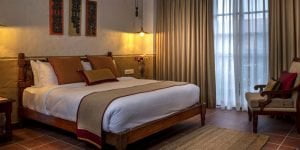Mera Peak Nepal
21 Days 4650 ex Kathmandu
Accommodation
3 Nights Hotel Stay
4 Nights Tent
13 Nights Tea House

Transportation
Mostly on foot
Transfers and domestic flights included
1 Porter 1 Trekker Policy

Included Meals
20 Breakfasts
17 Lunches
19 Dinners
All Open Menu Your Choice
Trip Grade
Category 4
Extreme Expedition – Cold
My crampons bit into the solid ice slope. Testing them, making sure they had traction, I pushed myself up, using my entire body to straighten my left knee so I was half a meter closer to the summit of Mera peak.
The air was cold and my hands even colder. My breathing was deep. I could see every breathe as I hoisted my way toward the icey dome above.
Over my shoulder, I could see the horizon start to glow a light blue. The sun was coming and night would soon be day.
It was at this point I began to get nervous. I could now see my surroundings and the height I was at. But the summit beckoned me. So I just kept my head down and ascended one step at a time.
As I reached the pinnacle, I looked around and saw the most beautiful mountain range I had ever seen. Jagged ridgelines sawed their away across the horizon. Glaciers spilled down every slope. And there was a quiet in the world and a quiet in me I had rarely experienced.
Unsurpassed views of the Himalayas with Everest (8848m), Cho-Oyu (8201m), Lhotse (8516m), Makalu (8463m), Kanchenjunga (8586m) as well as Nuptse (7855m) and Chamlang (7319m) visible.
“Absolutely fantastic trip to the summit of Mera Central. All credit to the handsome Nima and his brilliant team of guides, cooks, and porters. Support from arrival to departure was superb. Highly recommended and hope to visit and climb again.”
Nick – UK
Our Mera Peak climbing itinerary has been carefully crafted to ensure you receive proper acclimatisation along the way and you have been given proper climbing training before you head for the summit. We use longer and less trodden trails with gradual ascents to ensure proper acclimatisation, away from any crowds. With over 14 years of designing trips to Mera, we are confident you will be given every chance to reach her summit.
Part of our strategy is to set up high camp at about 5800m. In this way, we will have a shorter summit attempt. This camp is established on a rocky outcrop, protected from the elements by a large vertical wall. The summit day starts early in the morning and we approach the summit by the northern route – which involves a gradual climb with outstanding mountain panoramas.
We stay in the full-supported tented camps with EXPED down-filled mattresses, for extra comfort. As a safety precaution, we always carry a Portable Altitude Chamber (PAC) and Oxygen along with a comprehensive medical kit and a satellite phone for communication in case of emergency so you can be completely confident that your safety and comfort are our priorities. We provide all the personal and group climbing gears including LA-SPORTIVA’s Nepal Extreme climbing boots to make your trip to Mera Peak hassle-free and cost-effective.
So what are you waiting for? You have always wanted to try mountaineering. Mera Peak is a great summit to start your journey.
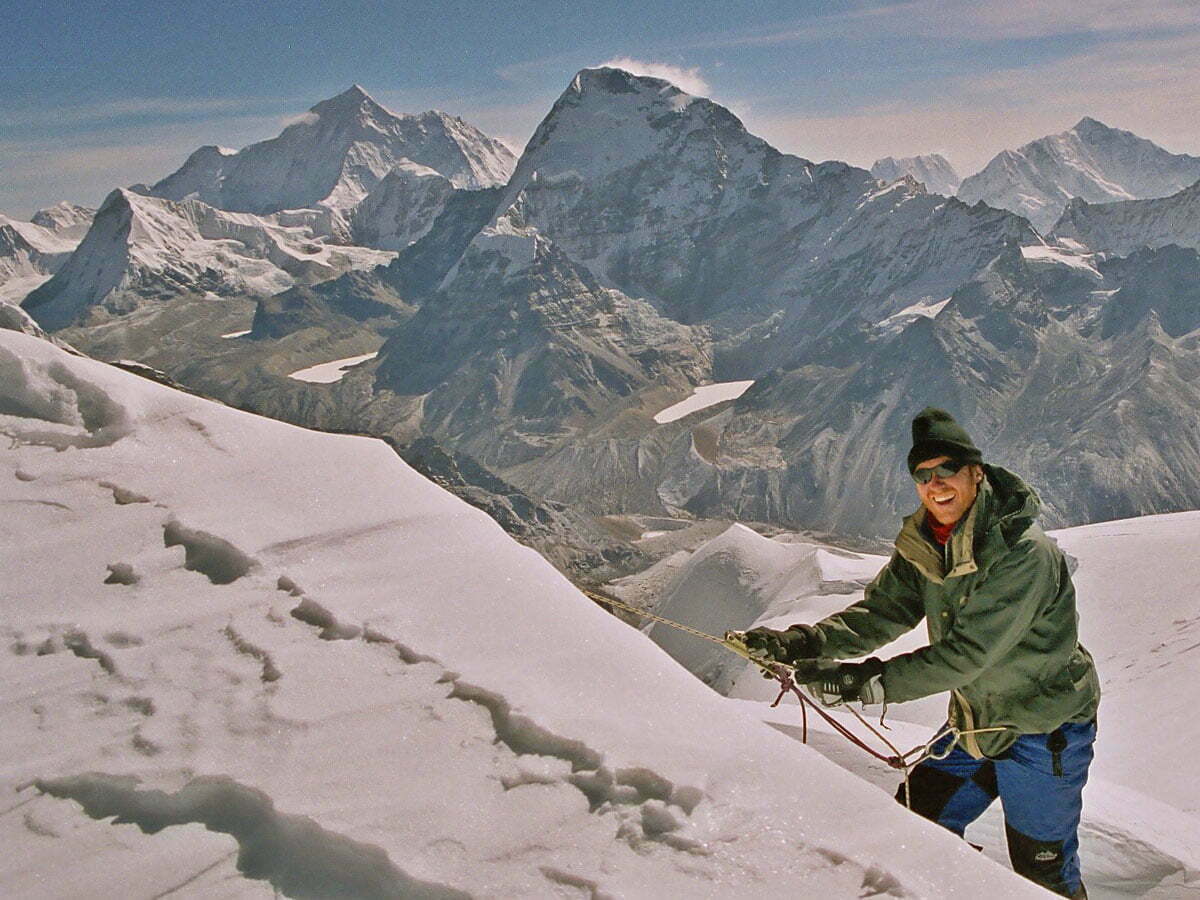
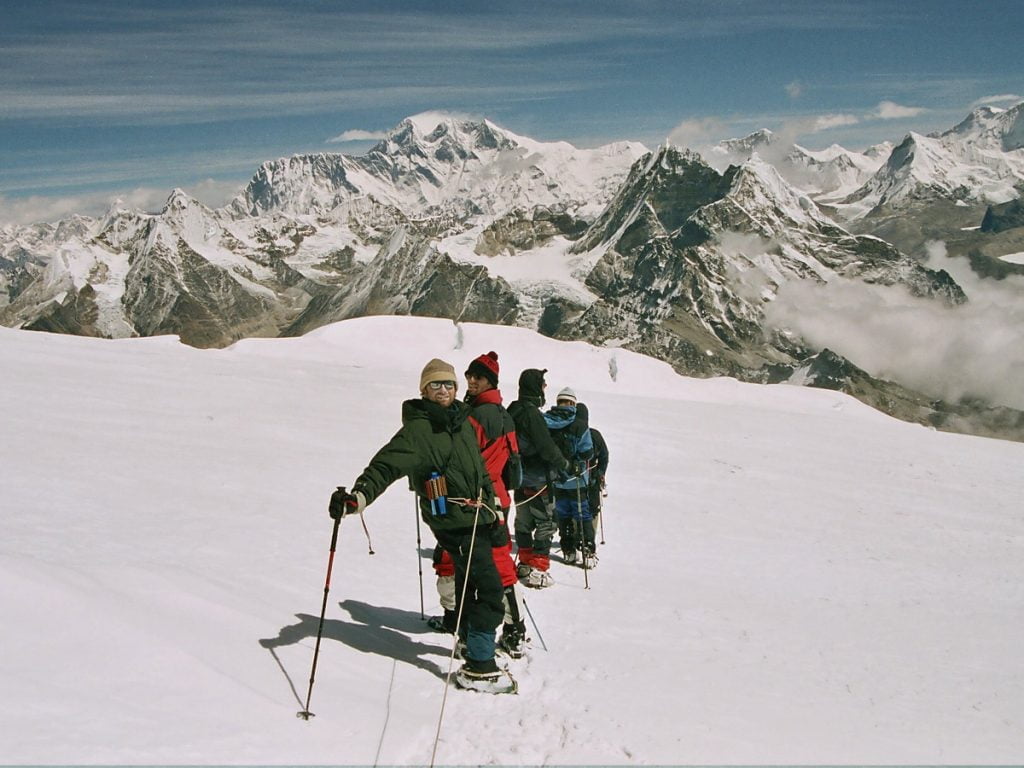
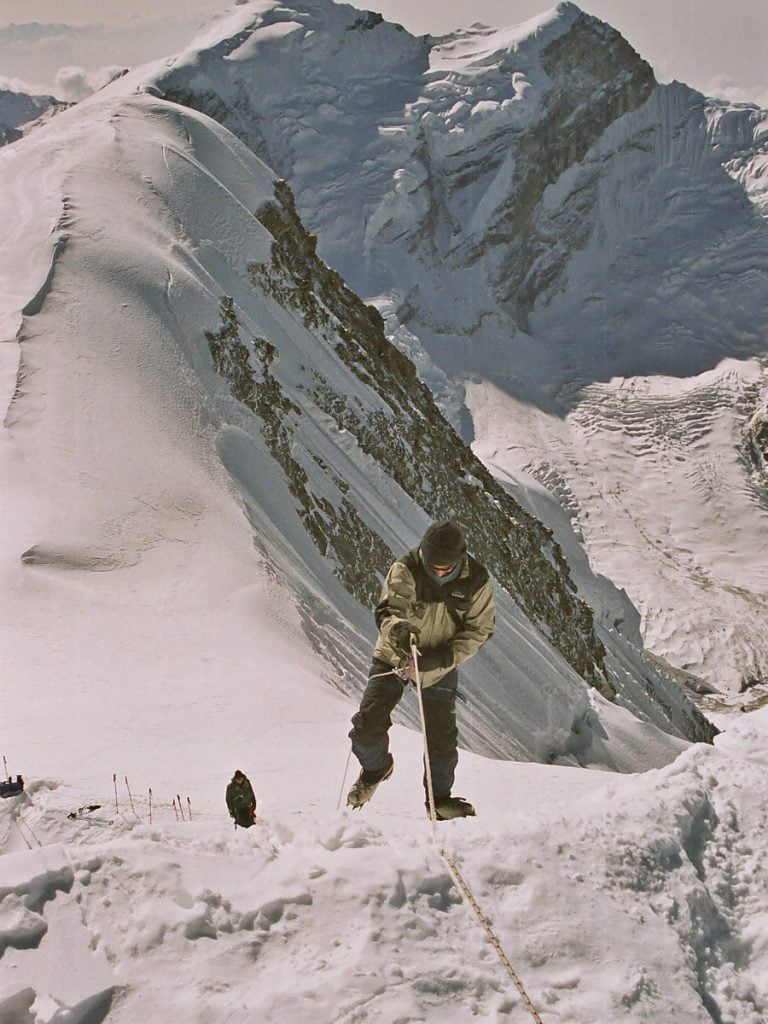
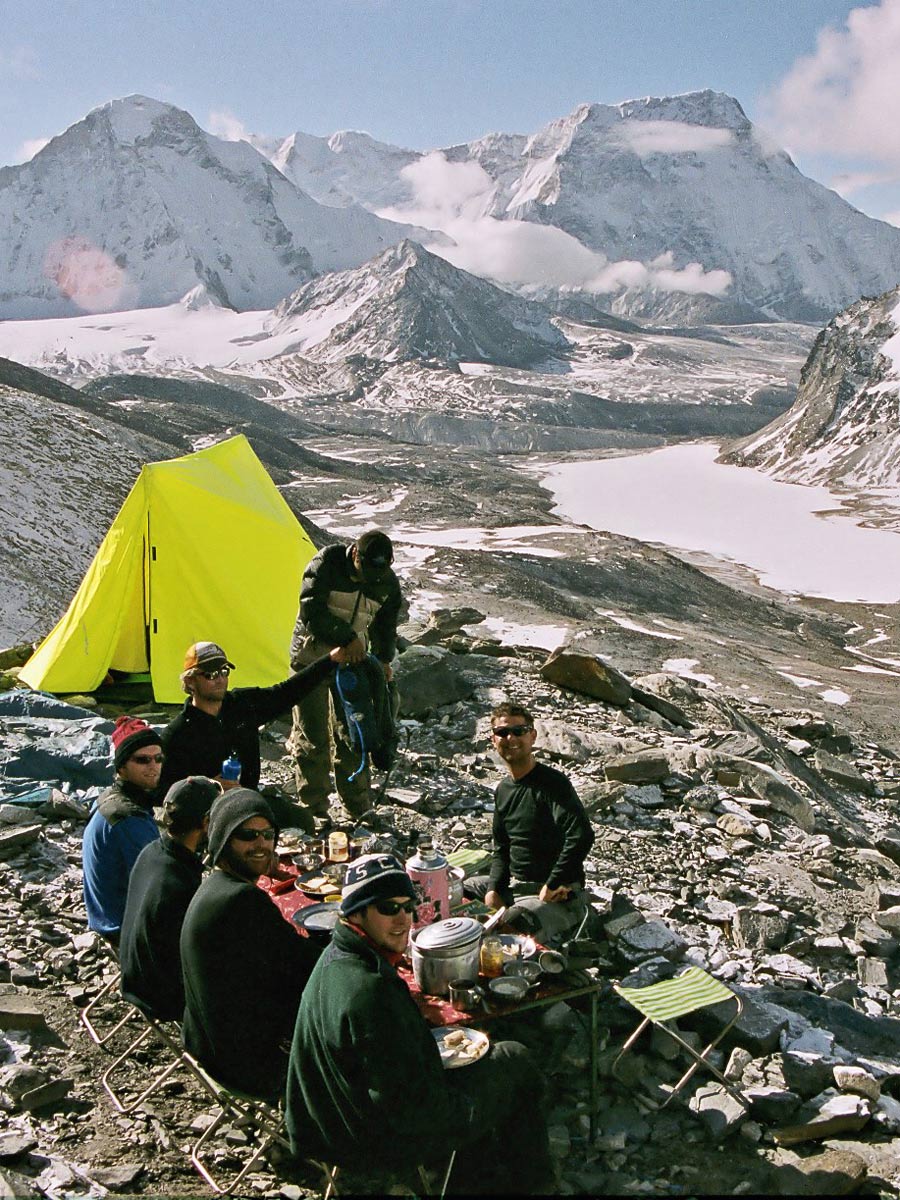
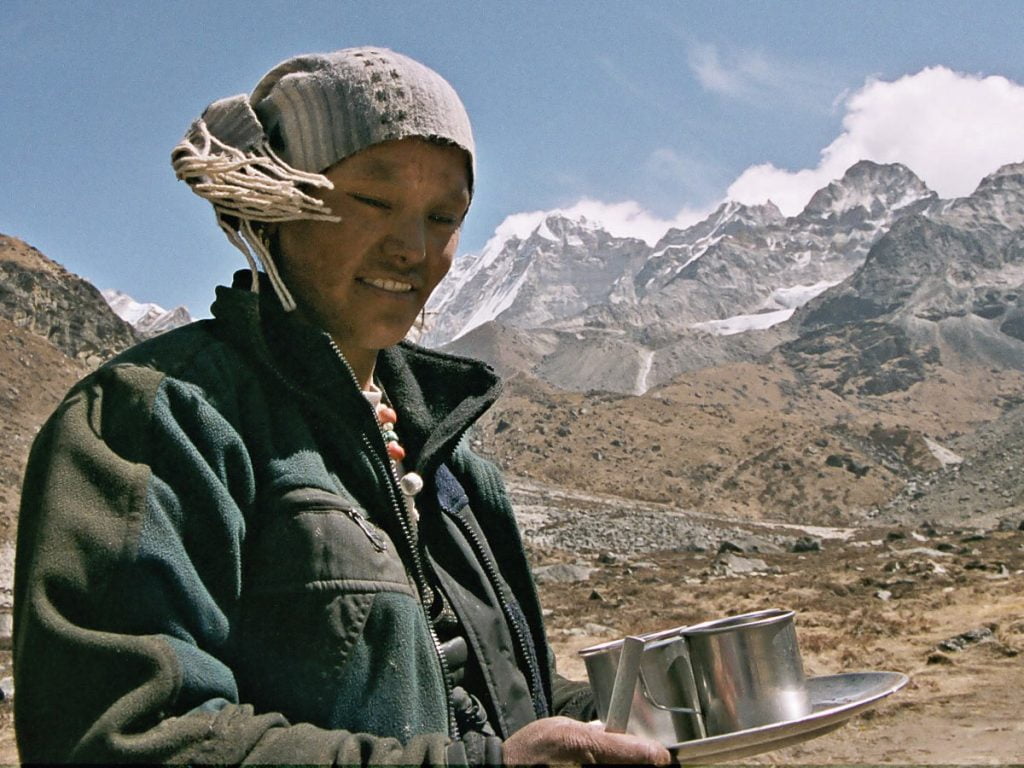
The Journey
Your group leader will meet you at the airport and take you to your hotel where you can relax, meet your teammates and take a stroll through Kathmandu’s bustling streets. We’ll enjoy a traditional Nepali dinner together and watch a cultural performance before getting much needed rest. (D)
Visit some of Kathmandu’s most noteworthy sights, including the white dome of Boudhanath and UNESCO’s Pasupatinath. You will learn about Nepal’s religious diversity while seeing ancient religious practices firsthand. At night, we’ll discuss the itinerary for our trek and what to expect in the days leading to Everest Base Camp.
After our flight to Lukla we will head away from the busy Everest Base Camp trail and head to Puiya.
This morning we follow the main trail before turning up a path into a magical forest and traversing numerous ridges to the majestic valley of the Kari Khola. Although camp elevations are similar to previous days, the Chutok La (2945m) and the Khari La (3080m) ridges undulate. As you approach Pangum, set in a small bowl like valley immediately below the Pangum La, you’ll pass through beautiful rhododendron, pine and oak forests. This little known trail is used only by locals and, apart from a few small settlements along the way, you’ll see little evidence of human activity. Pangum is an ancient settlement, with a new Gompa and expansive views out over the valley.
We start the day with a challenging half an hour climb to the Pangum La (3175m), this is your gateway to the Hinku Valley. Then negotiate a solid descent of around 900 metres to the Hinku River. Camp is high on the other side near the Surke La. Travel through a mix of farmed terraced slopes interspersed by undisturbed forests of maples, rhododendrons and fir.
After climbing up to the Surke La (3085m) you’ll follow the spine of the Surkie Danda ridge northwards towards Mera and the Hinku, enjoying spectacular views along the way. You’ll camp part way along at a yak herders clearing, or ‘kharka’, to experience real Himalayan life. The next few days are far from teahouse and trekkers trails, offering some of the finest wilderness trekking in Nepal.
Now we’re talking as we continue along the ridge, climbing higher and higher over knolls of up to 4500 metres. It’s well above the tree line, with grassy slopes, rocky outcrops and cliffs creating a unique landscape for trekking. Keep an eye out for birds of prey flying overhead such as griffon vultures, lammergeier and eagles. Descend to camp, near a series of five lakes, on the river of the Chunbu Drangka.
This is a very good place to have a rest day. You can recharge your batteries by taking in nature and the spectacular scenery. Spend some time taking stock of what you have achieved so far.
The route contours around ridges on the eastern side of the Hinku, descending into scree and rhododendron forests. Near the valley floor, encounter the devastation caused by the bursting of a natural damn destroyed the valley in 1998. There are vast boulders, dead trees and silt where ancient forests and meadows once stood.
Now in the Hinku Valley proper, cross a yak herders’ bridge to join the main trail. Pass the busy village of Kote, primarily servicing the trekking groups heading for Mera, following the riverbed trail. Gain your first views of dramatic peaks of the valley, including Kusum kanguru and an unnamed peak over 6700m, before reaching Tagnag. You’ll enjoy your first views of Mera from the confluence of the Sanu Drangka above Kote. This is your first foray into real mountain terrain.
A tough but steady four hour climb to the last camp below the snowline. You’ll hike through a lateral moraine with many grassy culverts. En route, glimpse the remains of Sabai Tsho Lake that was directly fed by massive, almost vertical glaciers. It is suspected an enormous avalanche of ice slipped into the lake, causing a wave that broke through the loose rocks that formed the wall on its far side. It’s a humbling reminder of the power of nature.
A day is set aside for further climbing preparations, practicing harness, crampons and ice-axe use, plus trekking while roped together. Everyone will be fully briefed before heading up onto the mountain, providing invaluable experience for all. Whilst the route itself is fairly straightforward, there are hazards, so a good basic technique and awareness of changing conditions is vital. Your guide will supervise the trek on the mountain, making decisions from the route taken and equipment used, through to people’s fitness (mental and physical) to proceed. The guides decision is always final as they’re responsible for the safety and well being of the expedition – no safety compromises will ever be made.
As long as the team ate already and weather is suitable, you’ll move up to the rock and glaciated camp just off the Mera La saddle, at approximately 5400m. Plastic mountaineering boots are usually worn from basecamp to the summit and back. Whilst they may feel a little clumsy, they are perfect for the job, providing warmth, protection and stability for the variable terrain. Another camp is set half way up the long north slope at about 5700m. Although it’s a shorter distance, it can be difficult in poor conditions and at altitude.
The summit bid will be made early in the morning (usually from 2-5am) taking around four to six hours. Whilst it might not look far it’s hard work but well worth it – all your training, preparation and positive attitude will pay off here. It’s usually necessary to rope up for much of the summit approach due to crevasse hazards. The route varies depending on the conditions but usually skirts around a major shoulder before traversing to the summit.
As dawn breaks, you’ll enjoy incredible views across to Baruntse (7129m), Chamlang (7319m) and Nau Lekh (6360m) with Makalu (8481m) looming behind. Further to the left is Everest, glimpsed over several unnamed peaks of the Hinku.
Due to the unstable nature of the summit it may be unsuitable to climb this final section, if this happens you’ll be designated an alternative summit a little further along the ridge. You’ll aim to make the summit early/mid-morning and return to basecamp at Kaare that afternoon.
The exact schedule depends on the weather, local conditions and how well the team’s doing. Our high quality equipment, experienced staff and time buffer all help achieve your goal. It’s a long day, but where the training, approach work, and right attitude combine to provide stamina and confidence, giving your team the best chance of summiting Mera.
This is a contingency day, allowing for inclement weather or poor conditions on the mountain. Those not wanting or able to continue on to the summit are able to stay comfortably at base camp enjoying the stunning mountain views all around. One or two staff members stay behind at camp, along with the porters.
Feeling tired but exhilarated, pack up and descend for two hours back to the permanent settlement in the valley. Enjoy a party and celebration meal, specially prepared by our cooks, in honour of your summit attempt.
Retracing your steps, follow the pastures and juniper meadows before dropping down to the riverbed and walking the boulder strewn path to Kote. It’s a large collection of timber huts spilling out on to the riverbed and very much a ‘half way house’ for porters and trekkers going to Mera.
Stroll through the forest beside the river, winding up through thick birch, rhododendron and pine. It’s not long before we break out of the forest and above the tree line, traversing around numerous ridges to the last camp at Chetrabu, or Thuli Kharka. It’s a solid seven hour day winding up to camp but you should be trekking fit by now, having established a steady pace to make it more manageable. In clear weather much of Mera Himal can be seen as a stunning reward for your climb.
A short, steady climb up to the pass of Zatrwa La (approx 4600m), then 45mins on to the pass of Zatrywa Ogg. The terrain is spectacular, with expansive views to the south and west, taking in Karyolug and Numbur and rows of foothills. Initially it’s a steep descent over rock slabs, snow and ice, which becomes steep pastures heading down to the rhododendron forests and the first signs of farming.
It’s a long way to the relatively mild environment of Lukla, so take your time and maintain a steady pace. However, the thought of cold drinks and a chance to put your feet up is great motivation. It goes without saying that there will be an end of trek party to complete your adventure.
Time at your leisure, maybe a massage is called for.
Depart for your next destination.
Includes
- Arrival and Departure transfers on both domestic and international flights.
- 3 nights accommodation at Harati Manor Hotel twin share
- OPEN and CHOICE of Full board meals while on expedition.
- One Trekker: One Porter Policy
- Accommodation at clean and comfortable tea houses or lodges.
- Welcome dinner with the cultural program as listed in the itinerary.
- Half-day guided city tour with world heritage entrance permit as listed in the itinerary.
- All Domestic flights and airport tax.
- Private transportation to and from the starting and ending points of the trek as applicable.
- Professional local experienced Trek Leader well trained in Wilderness First Aid with his support crew.
- Experienced Climbing guide with all his allowance and expenses.
- Trekking cook and other support staff while at Island Peak base camp
- Porters to carry all personal gear and group equipment with proper insurance and required gear
- Supplementary Oxygen cylinder regulator or Gamow Bag (A life-saving device in case of Acute Mountain Sickness) along with the comprehensive First Aid Kit.
- All required Personal and Group Climbing gear: LA SPORTIVA climbing boot, EXPED down-filled mattress, Black Diamond crampons, ice axe, Jumar, harness, the figure of eight, Carabiner, climbing Helmet and rope, etc.
- We provide all camping gear including – tents for members, dining tents with tables and backrest chairs, Kitchen tents with utensils, staff, porter, and toilet tents on the whole trip.
- Expedition Gear – sleeping bag, fleece inner liner, down jacket, rain poncho, etc for use during the trip.
- Mera Peak climbing expeditions Permit Royalty of US$ 250 only per person and other government tax.
- Climbing Clinic Course at base camp.
- Complimentary Trek Duffle bag, and trip map
- Mera Peak climbing certificates issued from the respective body of the Nepal Government for the successful climbers
- Trekking or VDC entry permit, Everest National park entry fees, etc
Excludes
- International flights
- Insurance
- Tips and beverages
Journey Extensions and Upgrades
Check out our Journey Extensions or Add Ons for those that want to stay a little longer or try something different along the way.
In the heart of Thamel, is the Nepali Ghar Hotel. The Nepali Ghar punctuates the new trend of modern hotels and breezes an ode to Nepalese traditional styles. These traditions afford a warm and homely environment for all adventurers. The hotels Delux rooms are luxurious and open with excellent facilities. The hotel has a restaurant that serves great food as well as a fitness centre.
If you would like to stay at the Nepali Ghar Hotel as part of your package of 2 nights before and 1 night after an expedition the extra price will be $600 (for all 3 nights).
For twin rooms where you share the room, the price is $350 per person twin share.
In the heart of Thamel, is the Nepali Ghar Hotel. The Nepali Ghar punctuates the new trend of modern hotels and breezes an ode to Nepalese traditional styles. These traditions afford a warm and homely environment for all adventurers. The hotel’s Delux rooms are luxurious and open with excellent facilities. The hotel has a restaurant that serves great food as well as a fitness centre.
If you would like to stay at the Nepali Ghar Hotel as part of your package of 2 nights before and 1 night after an expedition the extra price will be $350 per person twin share (for all 3 nights).
For single rooms for these nights the extra price is $600.
If you would like to have your own room in Kathmandu we can organise this. The Single Supplement for all Everest Trips is $300 per person. Single rooms are not available outside of Kathmandu.
“High camp was incredible. It was just sheer in every direction, glaciers disappearing straight down into nothing”
Ian – Australia
“We’ve been so looked after by our Sherpa team, they’ve gone beyond expectations I guess. The food, I don’t think we eat this well back home”
Stuart – Australia
Trek responsibly with trained porters and guides
Our team are committed to making sure your journey is a safe and memorable one. Each guest is paired with one porter (we have a 1 Porter 1 Trekker policy) to ensure a comfortable trek, and all of our guides receive medical and mountaineering training to make sure your experience is pleasant. We provide safety equipment and bring necessary medical supplies on each trip.
Prepare for an adventure of a lifetime
Before we begin our trek, our team will review our itinerary to Lukla and answer your questions about what to expect in the days leading to Mera Peak. Our journey to the base camp of Mera Peak will take us on a longer trail first, so we can adjust to the altitude before reaching our high camps. There, our climbing team will be set up and ready for us to learn the skills to climb. Summit day will start before sunrise and we hope to be on the summit to watch the sunrise over the Himalayas. Our return journey is via several more direct and higher altitude passes before we reach Lukla once again.
We get asked a lot of questions about our Mera Peak climb. The following are certainly the most common however if you have another question please let us know or the answer may be found in our Trip Notes section.
How hard is the climb to Mera Peak?
The climb to the summit of Mera Peak is a serious undertaking. While you do not need to have had any climbing experience, you will need to be fit and you will need to be able to handle heights. Several sections crossing the glacier on Mera Peak present crevasses that can be unnerving for some climbers. It can also be very cold with some summit attempts well below 0 degrees Celcius. Acclimatisation should be ok as we have several acclimatisation days along the way, but even still, the altitude will hamper normal progress.
We do suggest people who wish to undertake this climb, should have been to an altitude of 5000 meters or higher before, so that they understand the impact this can have on your body.
What about insurance what do I need?
This is one of the most common questions we get. Many insurance policies have activity limits as well as altitude limits. So on top of your general travel insurance that will cover you for the trek to and from the mountain, you will need specialist insurance to cover you for your activities on the mountain.
Global Rescue offers travel insurance without any restrictions on activities, elevation, places travelled, or nationality of its members. Contact them directly for a Travel Insurance Quote that will cover you for climbing. Click here to go to the Global Insurance website for a quote.
Do I have to bring my own climbing equipment?
Of course, if you have your own gear then we encourage you to bring it. However, Mera Peak is usually for those wishing to try climbing for the first time and we understand that purchasing all the equipment is an expensive undertaking.
So we provide the following: a very warm sleeping bag with warm fleece liners and feather duvet jackets which are the mother of all warm clothing. We also provide you with an individual waterproof trek Duffle bag to fit all your gear in.
For climbing we provide La Sportiva climbing boots, Black Diamond crampons, ice axe, ice bar, ice screw, Jumar, harness, the figure of eight, safety Helmet, plain and locking Carabiners, prussic cord and new climbing rope, etc.
We also provide Mountain Hardware 2 member tent, Exped down-filled mattress, and solar lights with a device charging facility. We use solar energy at Island peak base camp.
Note: While this is not always the case, climbing boots that are hired such as our La Sportiva can at times cause blisters, as your foot has not had a chance to adapt to the boots idiosyncracies.
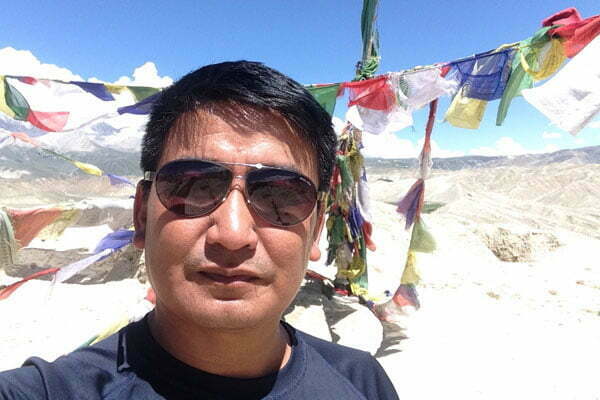
Mera Peak is the highest of the “trekking peaks” but it is often looked over for more famous “first time” summits such as Island. But Mera Peak is an awesome undertaking, away from the main Everest trails and sometimes crowds, from the summit it gives you a great appreciation of the entire Himalaya. Mera Peak offers enough technical climbing to give you a great first experience of what mountaineering is all about. I am sure Mera Peak will make you want to come back for more.
Pradip
Nepal Ops Manager


